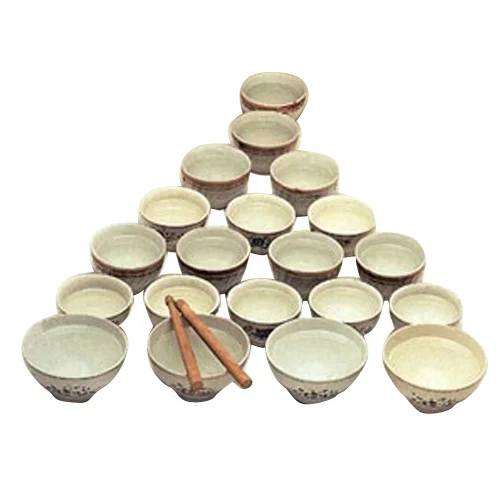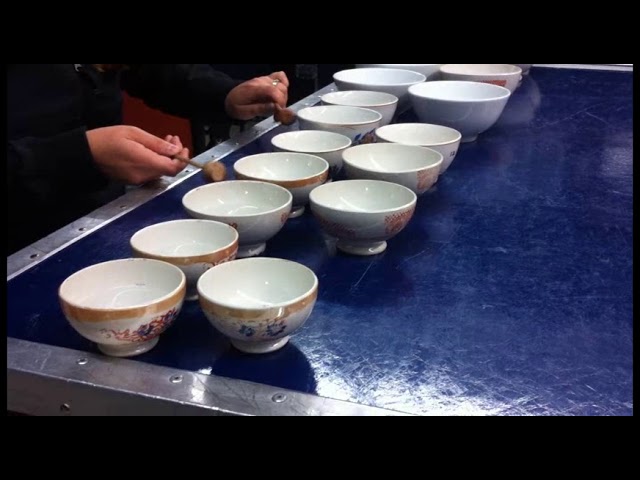Jal Tarang is a unique and fascinating musical instrument that belongs to the percussion family. It is one of the oldest instruments in Indian classical music and has a distinct way of producing melodies through water-filled bowls. The name “Jal Tarang” is derived from two Sanskrit words: “Jal,” meaning water, and “Tarang,” meaning waves. This instrument produces sound waves by striking the edges of water-filled ceramic or metal bowls with wooden sticks, creating a soothing and melodic tune.
Jal Tarang is one of the few instruments that rely on water to determine its pitch and tonal quality. Each bowl is tuned by adjusting the water level, and the musician skillfully strikes the bowls to create a rhythmic and harmonic sequence. This instrument is known for its soft and ethereal sound, making it ideal for classical and semi-classical performances. Although it is not as commonly used as other classical instruments, Jal Tarang has a deep-rooted history and continues to be appreciated for its unique sonic qualities.
History and Origin
Jal Tarang has an ancient origin and is believed to have been developed in the Indian subcontinent. Historical references to water-based musical instruments date back several centuries, indicating that Jal Tarang or similar instruments were used in early musical traditions.
Origin and Evolution
The Jal Tarang is mentioned in ancient Sanskrit texts on music, such as the “Natya Shastra” by Bharata, which was written around the 2nd century BCE. This indicates that water-based percussion instruments were in existence during that period. Over time, the instrument evolved, gaining prominence in Indian classical music and folk traditions.
The earliest form of Jal Tarang used earthen or metal bowls filled with different levels of water to create various pitches. Musicians experimented with the number of bowls and their tuning methods, leading to the standardized form seen today. The instrument was primarily used in royal courts and temple performances, where its melodious and calming sound complemented devotional and meditative music.
Although Jal Tarang originated in India, similar water-based instruments can be found in different cultures worldwide. In China and Japan, traditional water chimes and bowls were used in meditation and ritual music. However, Jal Tarang remains a distinctly Indian instrument, deeply embedded in its classical and folk traditions.
Types and Features of Jal Tarang
Jal Tarang can be classified based on the materials used for the bowls and the playing techniques. Although the fundamental principle remains the same—using water-filled bowls to produce sound—the variations in material and arrangement influence the tonal quality and resonance of the instrument.
Types Based on Material
Ceramic or Porcelain Jal Tarang – The most traditional and widely used type, these bowls are made of porcelain or ceramic. They produce a soft, clear, and pure tone, making them ideal for classical performances. The thickness and shape of the bowls contribute to the instrument’s tonal clarity.
Metal Jal Tarang – Some musicians use metal bowls, such as brass or bronze, to create a sharper and more resonant sound. While these bowls provide a different timbre, they are less commonly used in classical performances.
Glass Jal Tarang – Some modern adaptations of Jal Tarang use glass bowls. These bowls produce a bright, crisp sound and are often used in experimental and fusion music.
Features of Jal Tarang
The tuning of Jal Tarang is achieved by adjusting the amount of water in each bowl. The more water in a bowl, the lower the pitch, and the less water, the higher the pitch. This requires precision and a keen ear for musical notes. A standard Jal Tarang setup consists of 15 to 22 bowls, though some musicians may use fewer depending on the scale and complexity of the composition. The musician strikes the rim of the bowls gently with wooden sticks, creating a soft and resonant sound. The placement of the bowls and the striking technique contribute to the overall expressiveness of the performance.
Work Mechanics and Playing Technique
Jal Tarang is a percussion instrument but requires a melodic approach to playing. Unlike drums or other rhythm-based percussion instruments, Jal Tarang produces distinct musical notes and scales, making it unique in the percussion family.
How It Works
The principle behind Jal Tarang is based on the vibration of water and air within the bowls. When the musician strikes the rim of a bowl, it causes the water inside to vibrate, producing sound waves. The amount of water determines the frequency of these waves, affecting the pitch of the note.
The bowls are arranged in a semicircle in front of the musician, who sits cross-legged and uses wooden sticks to strike them. The spacing between the bowls allows for quick movement between notes, enabling smooth transitions and intricate melodic patterns.
Techniques Used in Playing
Soft Striking – A gentle tap on the rim of the bowl produces a delicate and resonant tone. This is the most commonly used technique in classical music.
Fast Rhythms – Some compositions require rapid successions of notes, achieved by quickly moving between bowls and striking them in succession.
Sliding Notes (Meend) – By slightly altering the water level while playing, musicians can create a sliding effect, similar to the “meend” technique in Indian classical music.
Damping – Some musicians use damping techniques by lightly touching the rim after striking to control the duration of the sound.
Role in Music
Jal Tarang is primarily used in Indian classical music, particularly in lighter classical and semi-classical genres. Although it is not a mainstream instrument in large orchestras, its presence in solo performances and accompaniment provides a unique tonal quality.
Jal Tarang is used in Hindustani and Carnatic music traditions. It is often played in alap (introductory improvisation) sections to set the mood before the main performance. The instrument’s soothing sound makes it ideal for devotional bhajans, chants, and meditation music. Its gentle vibrations create a tranquil atmosphere. In some regions, Jal Tarang is used in folk performances, where it complements vocals and other traditional instruments.Modern musicians have experimented with Jal Tarang by incorporating it into fusion genres, film scores, and electronic music. Its ethereal sound blends well with digital and acoustic elements.
Significance of Jal Tarang
Jal Tarang holds cultural and spiritual significance, making it more than just a musical instrument. Its association with water, one of the five classical elements in Indian philosophy, gives it a symbolic role in music and meditation.
Cultural Heritage – Jal Tarang is a part of India’s rich musical heritage. Though it is not as widely played today, efforts are being made to preserve and revive it in contemporary performances.
Spiritual Connection – The calming effect of Jal Tarang is often associated with spirituality and meditation. The vibrations produced by the water-filled bowls are believed to have a healing effect, similar to Tibetan singing bowls.
Symbol of Harmony – Since Jal Tarang relies on water levels for tuning, it symbolizes balance and harmony in nature. It teaches musicians patience and precision, making it a meditative and disciplined art form.
Educational Value – Learning Jal Tarang helps students develop a deep understanding of pitch, resonance, and musical intervals. It is often used in music therapy and educational programs.
Jal Tarang is a rare yet beautiful musical instrument that showcases the elegance of water-based sound production. Its history dates back centuries, making it an integral part of Indian classical music. Despite its decline in popularity, it remains a cherished instrument for those who appreciate its delicate and ethereal tones. With advancements in music and increasing interest in traditional instruments, Jal Tarang is gradually regaining recognition. Whether used in classical performances, meditation music, or fusion compositions, its unique charm continues to captivate audiences. As efforts to revive traditional music grow, Jal Tarang stands as a testament to India’s rich cultural and artistic legacy.
 Links
Links



















